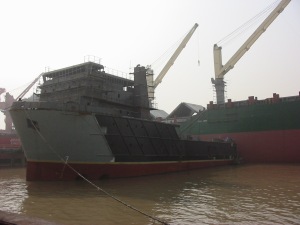Henderson International has been operating from Dubai, UAE for 29 years and with a back catalog of successful maritime operations and vessel designs it is worth looking back and describing what went into each of them; giving insight to our approaches and attitudes towards our work and contributions towards the international maritime sphere. Along with that, retrospectives are done as a reminder not only to successes and solutions to problems but also for the failures and in-depth understanding of problems themselves; helping those who also may encounter them in the line of duty, objectively covering many concepts.
The first retrospective is about the DMS “Conquest,” an Offshore Construction Support vessel that is the star of all our online representations and profiles; also commissioned by Doha Marine Services, acquired by Topaz Energy and Marine in 2008, who operates 25 vessels in the Middle East and North Africa (MENA) region; covering countries like Saudi Arabia, United Arab Emirates and Qatar. Topaz also operates in the Caspian regions.
The DMS “Conquest'” conceptual designs were agreed at DMS management where weather conditions and purposes were negotiated while the naval architecture was done by us. However, this process started with a flaw as the concrete purpose was still not properly negotiated as the vessel was built on a speculative gamble. (oilpubs.com, 2003) While the clients did get the consideration the process required the vessel was not built with a concrete purpose which introduces the first problem of maritime architecture.
The concept of the term speculative gamble hints towards uncertainty and simply throwing financial and manpower into the unknown; hoping something useful will be achieved. Gambling is a process which also associates with chance which means that all the precise nature of shipbuilding where every variable must be carefully planned for a successful, long-lasting vessel.
Leading onto the detailed design phase which was provided by us where we selected vessel machinery such as the type of engine and propulsion along with navigation equipment and electronics. The ship design process itself starts from the owner looking for a potential business on the maritime market who can address all the requirements of designing a vessel; analysing experience and history of the business in question. Ship type and operations are also finalised by the owner.
The design phase is also worked by a consultant who searches for a similar ship design which was constructed and proven before; known as a Sister vessel. This means that a new vessel design is always based on an existing design which was tried and possibly used. The Sister vessel variable therefore improves a vessel’s chances of being durable and reliable as regardless of speculative gamble; design was tried and worked.
Following Sister vessel consultancy comes the Design Spiral where the plans are negotiated and approved. Elements that are negotiated are:
- Mission requirements
- Cost estimates
- Damage stability
- Powering
- Structure
- Arrangements of hull and machinery
- Capacities
- Light ship weight estimate
- Floodable length and freedboard
- Proportions and preliminary powering
Finally, preliminary drawings and supporting calculations were submitted to be finalised by the owner; after whose approval the material is sent to the shipyard for construction. When the boat is constructed it is taken for sea trials to check its compliance to the design standard.
The entirety of all the processes has created a versatile vessel capable of dive support, topside construction and maintenance as well as acting as a crane vessel utilising 160t Liebherr telescopic, hydraulic crane; capable of lifting 44t. Also, able to accommodate 90 personnel in one man, two man and four man cabins, all fitted with self contained bathrooms facilities, she is well suited for a construction and maintenance role.
Overall, the DMS Conquest was a success and therefore the star of our online profiles. A versatile vessel that is capable of even more tasks as from 2003, DMS considered installing a helipad on it for even more function. However, with new additions come new issues as structure is compromised in terms of stability and mechanics attached to the new addition. That same helipad may affect balance with landing and holding of helicopters onboard.






